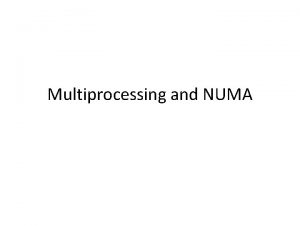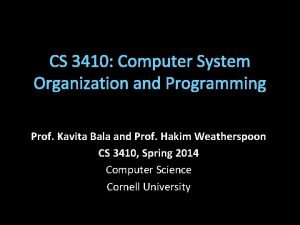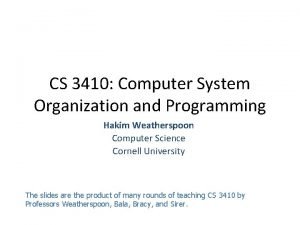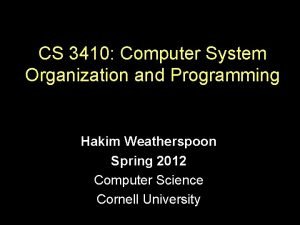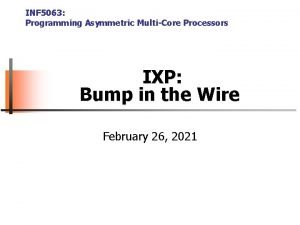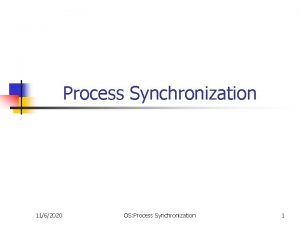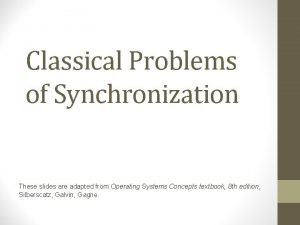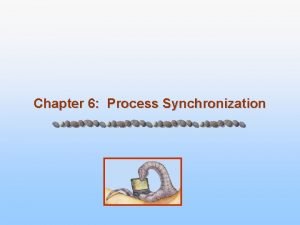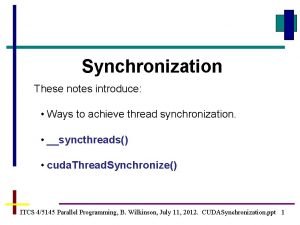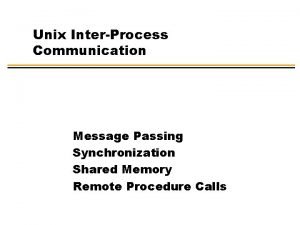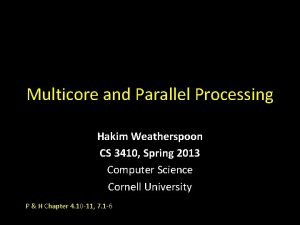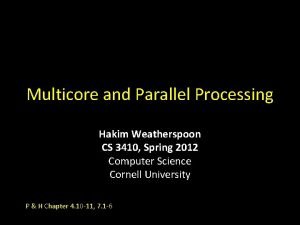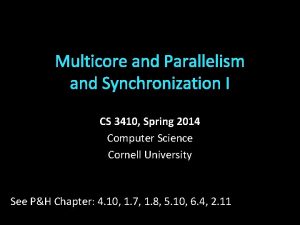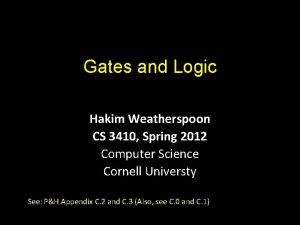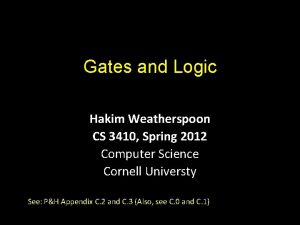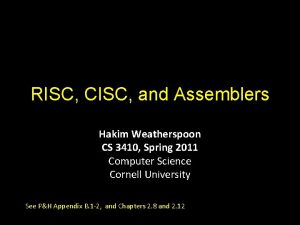Multicore Parallelism and Synchronization Hakim Weatherspoon CS 3410





















































- Slides: 53

Multicore, Parallelism, and Synchronization Hakim Weatherspoon CS 3410, Spring 2015 Computer Science Cornell University P&H Chapter 2. 11, 5. 10, and 6. 5

Announcements • HW 2 Review Sessions! • TODAY, Tue, April 21 st, Hollister B 14@7 pm • HW 2 -P 5 (Pre-Lab 4) was due yesterday! • PA 3 due Friday, April 24 th • The Lord of the Cache! • Tournament, Monday, May 4, 5 -7 pm

Announcements • Prelim 2 is next week on April 30 th at 7 PM at Statler Hall! • If you have a conflict e-mail me: deniz@cs. cornell. edu

Announcements Next three weeks • Week 12 (Apr 21): Lab 4 due in-class, Proj 3 due Fri, HW 2 due Sat • Week 13 (Apr 28): Proj 4 release, Prelim 2 • Week 14 (May 5): Proj 3 tournament Mon, Proj 4 design doc due Final Project for class • Week 15 (May 12): Proj 4 due Wed

Big Picture: Parallelism and Synchronization How do I take advantage of parallelism? How do I write (correct) parallel programs? What primitives do I need to implement correct parallel programs?

Topics: Goals for Today Understand Cache Coherency Synchronizing parallel programs • Atomic Instructions • HW support for synchronization How to write parallel programs • Threads and processes • Critical sections, race conditions, and mutexes

Parallelism and Synchronization Cache Coherency Problem: What happens when to two or more processors cache shared data?

Parallelism and Synchronization Cache Coherency Problem: What happens when to two or more processors cache shared data? i. e. the view of memory held by two different processors is through their individual caches. As a result, processors can see different (incoherent) values to the same memory location.

Parallelism and Synchronization

Parallelism and Synchronization Each processor core has its own L 1 cache

Parallelism and Synchronization Each processor core has its own L 1 cache

Parallelism and Synchronization Each processor core has its own L 1 cache Core 0 Cache Core 1 Cache Core 2 Cache Interconnect Memory I/O Core 3 Cache

Shared Memory Multiprocessors Shared Memory Multiprocessor (SMP) • Typical (today): 2 – 4 processor dies, 2 – 8 cores each • HW provides single physical address space for all processors • Assume physical addresses (ignore virtual memory) • Assume uniform memory access (ignore NUMA) Core 0 Cache Core 1 Cache Core 2 Cache Interconnect Memory I/O Core 3 Cache

Shared Memory Multiprocessors Shared Memory Multiprocessor (SMP) • Typical (today): 2 – 4 processor dies, 2 – 8 cores each • HW provides single physical address space for all processors • Assume physical addresses (ignore virtual memory) • Assume uniform memory access (ignore NUMA) Core 0 Cache Core 1 Cache . . Interconnect Memory I/O Core. N Cache

Cache Coherency Problem Thread A (on Core 0) Thread B (on Core 1) for(int i = 0, i < 5; i++) { for(int j = 0; j < 5; j++) { x = x + 1; } } What will the value of x be after both loops finish? Core 0 Cache Core 1 Cache . . Interconnect Memory I/O Core. N Cache

Cache Coherence Problem Suppose two CPU cores share a physical address space • Write-through caches Time Event step CPU A’s cache CPU B’s cache 0 Core 0 Cache Memory 0 Core 1 Cache . . Interconnect Memory I/O Core. N Cache

Two issues Coherence What values can be returned by a read Consistency When a written value will be returned by a read

Coherence Defined Informal: Reads return most recently written value Formal: For concurrent processes P 1 and P 2 • P writes X before P reads X (with no intervening writes) read returns written value – (preserve program order) • P 1 writes X before P 2 reads X read returns written value – (coherent memory view, can’t read old value forever) • P 1 writes X and P 2 writes X all processors see writes in the same order – all see the same final value for X – Aka write serialization – (else PA can see P 2’s write before P 1’s and PB can see the opposite; their final understanding of state is wrong)

Cache Coherence Protocols Operations performed by caches in multiprocessors to ensure coherence • Migration of data to local caches – Reduces bandwidth for shared memory • Replication of read-shared data – Reduces contention for access Snooping protocols • Each cache monitors bus reads/writes

Snooping for Hardware Cache Coherence • All caches monitor bus and all other caches • Bus read: respond if you have dirty data • Bus write: update/invalidate your copy of data Core 0 Snoop Cache Core 1 Snoop Cache . . Interconnect Memory I/O Core. N Snoop Cache

Invalidating Snooping Protocols Cache gets exclusive access to a block when it is to be written • Broadcasts an invalidate message on the bus • Subsequent read in another cache misses – Owning cache supplies updated value Time Step CPU activity 0 Bus activity CPU A’s cache CPU B’s cache Memory 0 1 CPU A reads X 2 CPU B reads X 3 CPU A writes 1 to X 4 CPU B read X

Writing Write-back policies for bandwidth Write-invalidate coherence policy • First invalidate all other copies of data • Then write it in cache line • Anybody else can read it Permits one writer, multiple readers In reality: many coherence protocols • Snooping doesn’t scale • Directory-based protocols – Caches and memory record sharing status of blocks in a directory

Takeaway: Summary of cache coherence Informally, Cache Coherency requires that reads return most recently written value Cache coherence hard problem Snooping protocols are one approach

Next Goal: Synchronization Is cache coherency sufficient? i. e. Is cache coherency (what values are read) sufficient to maintain consistency (when a written value will be returned to a read). Both coherency and consistency are required to maintain consistency in shared memory programs.

Synchronization • Threads • Critical sections, race conditions, and mutexes • Atomic Instructions • • HW support for synchronization Using sync primitives to build concurrency-safe data structures • Example: thread-safe data structures • Language level synchronization • Threads and processes

Programming with Threads Need it to exploit multiple processing units …to parallelize for multicore …to write servers that handle many clients Problem: hard even for experienced programmers • Behavior can depend on subtle timing differences • Bugs may be impossible to reproduce Needed: synchronization of threads

Programming with threads Within a thread: execution is sequential Between threads? • No ordering or timing guarantees • Might even run on different cores at the same time Problem: hard to program, hard to reason about • Behavior can depend on subtle timing differences • Bugs may be impossible to reproduce Cache coherency is not sufficient… Need explicit synchronization to make sense of concurrency!

Programming with Threads Concurrency poses challenges for: Correctness • Threads accessing shared memory should not interfere with each other Liveness • Threads should not get stuck, should make forward progress Efficiency • Program should make good use of available computing resources (e. g. , processors). Fairness • Resources apportioned fairly between threads

Example: Multi-Threaded Program Apache web server void main() { setup(); while (c = accept_connection()) { req = read_request(c); hits[req]++; send_response(c, req); } cleanup(); }

Example: web server Each client request handled by a separate thread (in parallel) • Some shared state: hit counter, . . . Thread 52 read. . . hits addiu hits = hits + 1; write hits. . . Thread 205 read. . . hits addiu hits = hits + 1; write hits. . . (look familiar? ) Timing-dependent failure race condition • hard to reproduce hard to debug

Two threads, one counter Possible result: lost update! hits = 0 T 1 time LW (0) ADDIU/SW: hits = 1 hits = 0 + 1 T 2 LW (0) ADDIU/SW: hits = 0 + 1 Timing-dependent failure race condition • Very hard to reproduce Difficult to debug

Race conditions Def: timing-dependent error involving access to shared state Whether a race condition happens depends on • how threads scheduled • i. e. who wins “races” to instruction that updates state vs. instruction that accesses state Challenges about Race conditions • Races are intermittent, may occur rarely • Timing dependent = small changes can hide bug A program is correct only if all possible schedules are safe • Number of possible schedule permutations is huge • Need to imagine an adversary who switches contexts at the worst possible time

Critical sections What if we can designate parts of the execution as critical sections • Rule: only one thread can be “inside” a critical section Thread 52 Thread 205 CSEnter() read hits addi write hits CSExit()

Critical Sections To eliminate races: use critical sections that only one thread can be in • Contending threads must wait to enter T 2 T 1 time CSEnter(); Critical section CSExit(); T 1 CSEnter(); # wait Critical section CSExit(); T 2

Mutexes Q: How to implement critical sections in code? A: Lots of approaches…. Mutual Exclusion Lock (mutex) lock(m): wait till it becomes free, then lock it unlock(m): unlock it safe_increment() { pthread_mutex_lock(&m); hits = hits + 1; pthread_mutex_unlock(&m); }

Mutexes Only one thread can hold a given mutex at a time Acquire (lock) mutex on entry to critical section • Or block if another thread already holds it Release (unlock) mutex on exit • Allow one waiting thread (if any) to acquire & proceed pthread_mutex_init(&m); pthread_mutex_lock(&m); # wait hits = hits+1; # wait pthread_mutex_unlock(&m); hits = hits+1; pthread_mutex_unlock(&m); T 1 T 2

Next Goal How to implement mutex locks? What are the hardware primitives? Then, use these mutex locks to implement critical sections, and use critical sections to write parallel safe programs

Synchronization requires hardware support • Atomic read/write memory operation • No other access to the location allowed between the read and write • Could be a single instruction – E. g. , atomic swap of register ↔ memory (e. g. ATS, BTS; x 86) • Or an atomic pair of instructions (e. g. LL and SC; MIPS)


Synchronization in MIPS Load linked: LL rt, offset(rs) Store conditional: SC rt, offset(rs) • Succeeds if location not changed since the LL – Returns 1 in rt • Fails if location is changed – Returns 0 in rt Any time a processor intervenes and modifies the value in memory between the LL and SC instruction, the SC returns 0 in $t 0, causing the code to try again. i. e. use this value 0 in $t 0 to try again.

Synchronization in MIPS Load linked: LL rt, offset(rs) Store conditional: SC rt, offset(rs) • Succeeds if location not changed since the LL – Returns 1 in rt • Fails if location is changed – Returns 0 in rt Example: atomic incrementor Time Step Thread A Thread B 0 Thread A Thread B $t 0 Memory M[$s 0] 0 1 try: LL $t 0, 0($s 0) 2 ADDIU $t 0, 1 3 SC $t 0, 0($s 0) SC $t 0, 0 ($s 0) 4 BEQZ $t 0, try

Mutex from LL and SC Linked load / Store Conditional m = 0; // m=0 means lock is free; otherwise, if m=1, then locked mutex_lock(int *m) { while(test_and_set(m)){} } int test_and_set(int *m) { old = *m; LL Atomic SC *m = 1; return old; }

Mutex from LL and SC Linked load / Store Conditional m = 0; // m=0 means lock is free; otherwise, if m=1, then locked mutex_lock(int *m) { while(test_and_set(m)){} } int test_and_set(int *m) { try: LI $t 0, 1 LL $t 1, 0($a 0) SC $t 0, 0($a 0) BEQZ $t 0, try MOVE $v 0, $t 1 }

Mutex from LL and SC Linked load / Store Conditional m = 0; // m=0 means lock is free; otherwise, if m=1, then locked mutex_lock(int *m) { while(test_and_set(m)){} } int test_and_set(int *m) { try: LI $t 0, 1 LL $t 1, 0($a 0) SC $t 0, 0($a 0) BEQZ $t 0, try MOVE $v 0, $t 1

Mutex from LL and SC Linked load / Store Conditional m = 0; mutex_lock(int *m) { test_and_set: LI $t 0, 1 LL $t 1, 0($a 0) BNEZ $t 1, test_and_set SC $t 0, 0($a 0) BEQZ $t 0, test_and_set } mutex_unlock(int *m) { *m = 0;

Mutex from LL and SC Linked load / Store Conditional m = 0; This is called a Spin lock mutex_lock(int *m) { Aka spin waiting test_and_set: LI $t 0, 1 LL $t 1, 0($a 0) BNEZ $t 1, test_and_set SC $t 0, 0($a 0) BEQZ $t 0, test_and_set } mutex_unlock(int *m) { SW $zero, 0($a 0)

Mutex from LL and SC Linked load / Store Conditional m = 0; mutex_lock(int *m) { Time Thread A Step Thread B 0 Thread B $t 0 Thread Mem B $t 1 M[$a 0] 0 1 try: LI $t 0, 1 2 LL $t 1, 0($a 0) 3 BNEZ $t 1, try 4 SC $t 0, 0($a 0) SC $t 0, 0 ($a 0) 5 BEQZ $t 0, try 6 Thread A $t 0 A $t 1

Mutex from LL and SC Linked load / Store Conditional m = 0; This is called a Spin lock mutex_lock(int *m) { Aka spin waiting test_and_set: LI $t 0, 1 LL $t 1, 0($a 0) BNEZ $t 1, test_and_set SC $t 0, 0($a 0) BEQZ $t 0, test_and_set } mutex_unlock(int *m) { SW $zero, 0($a 0)

Mutex from LL and SC Linked load / Store Conditional m = 0; mutex_lock(int *m) { Time Thread A Step Thread B 0 1 2 3 4 5 6 7 8 9 Thread A $t 0 A $t 1 Thread B $t 0 Thread Mem B $t 1 M[$a 0] 1 try: LI $t 0, 1

Now we can write parallel and correct programs Thread A Thread B for(int i = 0, i < 5; i++) { for(int j = 0; j < 5; j++) { mutex_lock(m); x = x + 1; x = x + 1; mutex_unlock(m); }

Alternative Atomic Instructions Other atomic hardware primitives - test and set (x 86) - atomic increment (x 86) - bus lock prefix (x 86) - compare and exchange (x 86, ARM deprecated) - linked load / store conditional (MIPS, ARM, Power. PC, DEC Alpha, …)

Synchronization techniques clever code • must work despite adversarial scheduler/interrupts • used by: hackers • also: noobs disable interrupts • used by: exception handler, scheduler, device drivers, … disable preemption • dangerous for user code, but okay for some kernel code mutual exclusion locks (mutex) • general purpose, except for some interrupt-related cases

Summary Need parallel abstractions, especially for multicore Writing correct programs is hard Need to prevent data races Need critical sections to prevent data races Mutex, mutual exclusion, implements critical section Mutex often implemented using a lock abstraction Hardware provides synchronization primitives such as LL and SC (load linked and store conditional) instructions to efficiently implement locks
 Hakim weatherspoon
Hakim weatherspoon Hakim weatherspoon
Hakim weatherspoon Instruction level parallelism vs thread level parallelism
Instruction level parallelism vs thread level parallelism Multiprocessor and multicore
Multiprocessor and multicore Rfc 3410
Rfc 3410 Cornell cs 3410
Cornell cs 3410 Cs 3410
Cs 3410 Cs 3410
Cs 3410 Cs 3410
Cs 3410 Cs 3410
Cs 3410 Cs 3410
Cs 3410 Cs 3410
Cs 3410 Speedy transactions in multicore in-memory databases
Speedy transactions in multicore in-memory databases Multicore packet scheduler
Multicore packet scheduler Multiprocessor programming
Multiprocessor programming Amdahl's law in the multicore era
Amdahl's law in the multicore era Cache craftiness for fast multicore key-value storage
Cache craftiness for fast multicore key-value storage Pxie-pcie8372
Pxie-pcie8372 Obs multicore
Obs multicore Asymmetric multicore processing
Asymmetric multicore processing Sae international
Sae international Yabancı bir milletin himaye ve efendiliğini
Yabancı bir milletin himaye ve efendiliğini Dedi budiman hakim
Dedi budiman hakim Hakim isa
Hakim isa Cecep maskanul hakim
Cecep maskanul hakim Reshra ne demek
Reshra ne demek Wasim hakim
Wasim hakim Hakim salim khan
Hakim salim khan Wasyawirhum fil amri
Wasyawirhum fil amri Hakim abdul hameed
Hakim abdul hameed Pasal 666 kuhperdata
Pasal 666 kuhperdata Mensturation
Mensturation Dr mazen al hakim
Dr mazen al hakim Hakim boulouiz
Hakim boulouiz Synchronization algorithms and concurrent programming
Synchronization algorithms and concurrent programming Fast clock to slow clock synchronization
Fast clock to slow clock synchronization Is high level synchronization construct
Is high level synchronization construct Process synchronization in os
Process synchronization in os Data synchronization in tally erp 9
Data synchronization in tally erp 9 Multiprocessor synchronization
Multiprocessor synchronization Lean synchronization
Lean synchronization Show bgp neighbor
Show bgp neighbor Lock free synchronization
Lock free synchronization Classical problems of synchronization
Classical problems of synchronization Synchronization tools in os
Synchronization tools in os Process synchronization in os
Process synchronization in os Basic synchronization principles
Basic synchronization principles Windchill logout
Windchill logout Syncthreads
Syncthreads Process synchronization definition
Process synchronization definition Laser synchronization
Laser synchronization Pthread synchronization
Pthread synchronization Shared memory in unix
Shared memory in unix Synchronization primitives c#
Synchronization primitives c#



